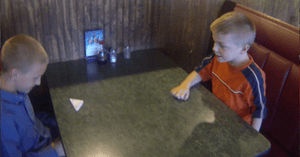Paper football facts for kids
Paper football is a fun tabletop game. It's a bit like American football, but you play it with a small triangle of paper on a table. Players slide or flick the paper "football" back and forth. This game is very popular for entertainment, especially among students in elementary, middle school, and high school in the United States. It's a great way to pass the time with friends!
Contents
How to Make a Paper Football
Making a paper football is easy and usually only needs one sheet of paper. You fold the paper in a special way to make a triangle shape.
- First, fold the paper lengthwise two or three times. This makes a long, thin rectangle.
- Next, start folding it diagonally, over and over. This will create the triangle shape.
- Finally, tuck the end of the paper strip into the last fold. This keeps your paper football in its perfect triangular shape.
If you don't have paper, you can sometimes use other small items. Things like sugar packets, matchbooks, or even foil-wrapped cookies can work as a substitute for the ball.
How to Play Paper Football
There are many ways to play paper football, but most versions are loosely based on American football. Two players usually sit facing each other across a table, which acts as the playing field.
To start the game, you can flip a coin. The winner gets to "kick off" first. After the kickoff, players try to move the ball by flicking it across the table. Each flick is like a "drive" in football. The main goal is to score a touchdown!
Some games are very simple, just flicking the ball back and forth to score "field goals." Other games can be more detailed. They might include rules for things like "touchbacks," "penalties," or "first downs."
Starting the Game: The Kickoff
A kickoff begins the game. The player who is kicking holds the paper football under a fingertip on their side of the table. Then, they flick (or "kick") it with a finger from their other hand. The goal is to send it towards the other player's side of the table.
The player receiving the ball gets to take possession where the ball stops. If any part of the ball hangs over the end of the table, it's called a touchback. If this happens, the receiving team gets to start play a certain distance away from their end zone.
There are a few ways to do a kickoff:
- Some players place the ball on the edge of the table with one corner hanging over. Then they flick it towards the opponent's side.
- Other players use a one-handed kickoff. They hold the ball in their palm, then toss it onto the table by hitting their fingers on the underside of the table.
It's a good idea to agree on the kickoff method before you start playing!
Moving the Ball: Flicking and Advancing
The main part of the game is sliding the paper football across the table by flicking it. A legal flick or "shot" means you advance the ball by flicking or hitting it. You are not allowed to push the ball.
Most players flick the ball with their thumb and forefinger. This is similar to how you might shoot marbles. You can also use another method that feels comfortable. Using objects like pencils to strike the ball is less common.
Players usually get four chances, called "downs," to score a touchdown. If they can't score a touchdown, they can try for a field goal on their fourth down.
Scoring Points
Teams score points in paper football in a few ways:
Touchdown
A touchdown (TD) is worth 6 points, just like in American football. You score a touchdown when you flick the ball, and it comes to rest with part of it hanging over the edge of your opponent's side of the table. But be careful! If the ball falls to the ground, it's considered a touchback.
If it's your fourth down and you don't think you can score a touchdown, you can try for a field goal instead. A field goal is worth 3 points.
Sometimes, it's hard to tell if a touchdown has been scored. You can use a flat object, like a ruler, and slide it across the edge of the table near the ball. If the object moves the ball, then it's a touchdown!
Extra Points
After scoring a touchdown, the player usually gets a chance to score an extra point. This is called an "extra point" or "point-after touchdown." It's worth 1 point. You can also try for a "two-point conversion," which is worth 2 points.
- Point After Touchdown: Your opponent holds their fingers up to make a "goalpost." You then flick the ball through the air. If the center of the ball goes through the imaginary area between their "uprights" (fingers) and over their "crossbar" (bottom fingers), it's successful. Even if it bounces off their fingers but still goes through, it counts!
- Two Point Conversion: For this, you get one try to flick the ball over the edge of the table, similar to scoring a touchdown. You start this attempt from the middle of the table.
After scoring, the game usually restarts with a new kickoff by the scoring player, or the other player gets possession. This depends on the "house rules" you agree on.
Field Goals
A field goal is when a player holds the ball with one hand (usually resting on the table). Then, they flick the ball with their other hand. The goal is to make it go through a "goalpost" made by the opposing player's fingers. Field goals usually score 3 points.
Sometimes, games are played where only field goals are scored. In these versions, each successful field goal is often worth only one point.
Here are some variations for field goals:
- If your team gets possession in the other team's territory (for example, after a penalty), you can try for a field goal instead of a touchdown. The defender can place their finger goalposts anywhere on their goal line. You must kick the ball from exactly where it stopped, or from where it left the table.
- Some players allow a field goal attempt after a touchback. This field goal is worth three points. In some games, you only get this option after a certain number of touchbacks.
Penalties
To keep the game fair, there are rules about what you can't do. Things like pushing the ball too much, flicking it twice, kicking the ball far off the table, or bothering the ball during your opponent's turn can lead to penalties. This depends on the game's rules.
Usually, a penalty means the ball moves closer to the offender's side of the table, which helps the opponent. If you're playing with "downs," the player who committed the penalty might lose a down. Or, the opponent's play might not count as a down. Plus, the opponent gets to move the ball to a better spot.
Game Length
The length of a paper football game can vary. You might play until someone reaches a certain score, like 10 or 21 points. Or, you might play until a certain time, like the end of a class period at school. Games are usually played quite quickly, especially on smaller tables.
If the game ends in a tie, there are ways to break it. One common way is "sudden death." If the game is tied when time runs out, the first player to score any points wins the game!
Variations of the Game
Paper football has been played in many different ways over the years:
- In the 1950s, in the American Midwest, people sometimes used matchbooks as the footballs.
- Some versions allow players only one chance to move the ball over the goal line per turn, instead of four downs. If a player pushes the ball off their opponent's end of the table, it's a "strike." After 3 strikes, the opponent can try for a field goal worth 3 points.
- In Connecticut in the 1950s, people played a version using an American quarter. Players had 4 downs to move the quarter up the table and hang it over the edge for a touchdown. If it fell off or they failed to hang it, the opponent got possession. Players could try a field goal by hanging the quarter over their own edge and "kicking" it with their index finger towards the opponent's finger goalposts. The player with the highest score won the opponent's quarter. This version was often avoided in school because the quarter made too much noise!
- Sometimes, a classroom variation uses a study guide or test. Each player takes turns answering a question. If they answer correctly, they get to take possession of the ball and play it from its current spot on the table.
See also
 In Spanish: Balompié de papel para niños
In Spanish: Balompié de papel para niños



